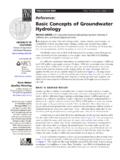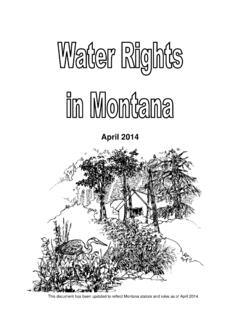Transcription of Spectrophotometric Determination of Phosphates in Water
1 Spectrophotometric Determination of Phosphates in WaterBackgroundControlled concentration of phosphorus in Water is critical for a stable ecosystem. Aquatic plants are depen-dent on a certain amount of phosphorus in order to survive; however, excess phosphorus leads to eutroph-ication, the over enrichment of a Water body with nutrients. This can lead to a surge in biomass growthmanifesting as an algal bloom that blocks sunlight from other aquatic plants and starves the Water of oxygenadversely effecting the environment. The EPA Water Quality Criteria recommends a maximum phosphorusconcentration of 100 g/L in rivers and streams and 25 g/L in lakes in order to prevent eutrophication fromoccurring.
2 Phosphorus is also found in tap Water where it is added in order to inhibit corrosion of piping- a thin layer of phosphorus builds up on the inside of the pipes and prevents any metals from seepinginto the Water . A maximum phosphorus concentration of g/L is mandated by the California WaterResources Control Board. In this experiment, you will measure phosphorus concentrations in Water fromseveral locations by spectrophotometry with a molybdate complex that turns dark blue in the presence phosphorus cycle is a simple method to comprehend the role phosphorus plays in the phosphorus has limited methods to enter vapor form, the cycle predominately moves through organismsand ground / Water phases.
3 Phosphorus is essential to various biological compounds in organisms, such asDNA and proteins. When organisms die, the organic phosphorus taken up by the organism returns to thesoil. Various bacteria and fungi initiate processes that then break down the phosphorus which is eitherpicked up by ground Water or rainfall and swept into rivers and lakes, or it may build up as sediment in amineralization process leading to phosphorus rich rocks and minerals that may erode later on. Alternatively,plants can uptake the phosphorus from the soil is present mainly in the form of Phosphates .
4 These Phosphates exist in three forms. Organicphosphates exist in biological systems and play a role in the life cycle of the organism. An example wouldbe adenosine triphosphate (ATP) that provides energy to cells. Metaphosphates are found in inorganicstructures such as metals and salts. Orthophosphates are the simplest form of phosphate . Unlike organicphosphates and metaphosphates which are not readily available, orthophosphates are reactive forms ofphosphate in Water and can be directly can seep into the environment from both natural sources and man-made sources.
5 Naturalsources include rocks, minerals, and sediment while man-made sources include fertilizers and US states have banned phosphate detergents leading to most detergent companies reformulating theirproducts. phosphate -based fertilizers are especially effective at growing crops and are therefore used onmany fields. Any rainfall over a field will drain into a body of Water and lead to high concentrations ofphosphorus. This can be extremely problematic in agricultural regions such as the central valley where asignificant portion of land gets fertilized causing large increases in Phosphates in surrounding rivers SourcesThe Arboretum Waterway extends throughout the UC Davis Arboretum along what was once the northfork of Putah Creek which was diverted away from Davis in the 1870s to prevent farmland flooding - thiswaterway is only connected to Putah Creek if its Water levels are very high and Water is allowed to
6 Escape1 Figure 1: Schematic of the phosphorus cycle illustrating the mechanism by which phosphorusnaturally enters rivers and lakesand drain into the creek. Today the Arboretum Waterway is effectively a storm Water basin collecting rainwater that falls onto the central UC Davis Creek flows through mile through mostly urban areas in Sacramento County. Because itswatershed is almost completely urbanized, Arcade Creek is also susceptible to Water quality issues makingit a suitable Water source to study in this method we will use to measure the concentration of pollutants in the Water is called Spectrophotometry,which is a procedure that determines how much a chemical compound absorbs and transmits light.
7 Havingthe light absorbance profile of a solution, we can compare it with a known sample and identify whichcompounds are present and also their quantities. Spectrophotometry has an immense importance in thescientific community, being one of the most widely used methods for quantifying compounds in differentfields such as chemistry, physics, and biology. One of the most common uses of spectrophotometry is theanalysis of Water samples, which will be explored in this spectrophotometer measures the intensity of light that passes through a solution.
8 This is accomplishedby shining light at a specific wavelength through a solution and comparing the intensity with a referenceblank. Figure 2 depicts a simple spectrophotometer setup. The spectrophotometers in this lab differ slightlyfrom that depicted - a series of LEDs outputting light at specific wavelengths replaces the white light sourceand monochromator. Fundamentally the mechanism at play is are only able to emit and detect light within a specific wavelength range and areclassified accordingly. For example, a common type is the UV-visible spectrophotometer that emits andabsorbs photons with wavelengths in the ultraviolet range (185 nm to 400 nm) and visible range (400 nm to700 nm), while another type, the IR spectrophotometer, uses wavelengths in the infrared range (700 nm to1500 nm).
9 The most accessible of these types is the visible light spectrophotometer, which will be used in thisexperiment. Particularly for visible light Spectrophotometry, the solutions color can be used as an indicatorof the solutions light absorptivity and transmissivity. For example, if a solution absorbs red light it will2 Figure 2: Basic schematic of a spectrophotometer, from green since these are complementary colors. Certain chemical compounds absorb light at specificwavelengths unique to the system.
10 If the solute is present in a higher concentration, more light will beabsorbed as described by the Beer-Lambert equation, also known as Beer s Law. This expression relates theabsorbance to the solute concentration in a given solutionA=eLc(1)whereAis the compounds absorbance (unitless),eis the molar absortivity (L/(mol cm)),Lis the pathlength (cm) andcis the compound concentration (mol/L). Beer s law is dependent on several assumptionsthat are explored in the pre-lab section. In order to obtain quantitative absorption data a set of standardswith known concentration must be analyzed in order to create a list of values to compare with the this experiment, orthophosphates react with ammonium heptamolybdate to form a phosphomolybdicacid.






